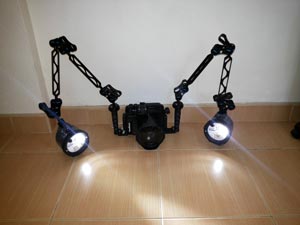My 10 secret Tips on how to take instantly better underwater Pictures. Good Photography on Land is already hard but underwater it’s twice as difficult!
I’ll give you 10 of my secret tips for free on how you can improve your underwater Photography instantly with one click!
1. Invest in a high quality underwater Camera

It is important to have a high quality Camera as the cheap ones just don’t make the cut.
The better the Compact Camera the better underwater pictures you can take but obviously the more expensive the camera will be too.
Low light camera ability and lens performance is an interesting feature to look for in a good compact underwater camera.

Underwater Cameras often come with a housing or you can buy a seperate housing for the camera model. Make sure you buy the housing for the exact model otherwise buttons might not be functional or the camera just wont fit into the housing.
Compact Camera underwater Housings are mostly rated to around 40m (130 ft) and are mostly made from transparent polycarbonate material

However there are cameras on the market which rate to 30m (100 ft) without housing like the Panasonic DC-TS7D Lumix.
This kind of cameras only have a small O-Ring on the Battery chamber and are otherwise completely sealed. Be carefull with the Battery O-Ring it is very delicate!

Also Nikon prduces a Camera rated to 30m called W300. We here prefer the nikon over the Panasonic.
For beginners the camera does not always have to be a DSLR or a mirrorless.
Even with a high quality compact camera you can take awseome underwater pictures too and you can get into smaller spaces as the rig is much smaller. They are much less expensive. Also in case of flooding the housing. as well as lighter for transporting.

If you are experienced have a really good buoancy control and know scuba diving without a camera, you can think of DSLR like the Canon EOS R6 or a mirrorless like the Sony a7, and lenses, and housing, and ports, and tray and strobes and all the other stuff too! But you already notice they are very expensive.
Not only the camera but especially the housing. All together a big rig will cost you an average of around 6000,- US$ but you can spend much much more.
Bestseller on the market (housing is necessary for this camera)
2. Know your Camera a 100% on Land

Know your Camera a 100% on land before you take it underwater. As you know underwater you have a lot of other things to do apart from operating your camera. Buoyancy control, fin kicking, not smashing into rocks or corals, checking your air, checking your depth and so on. So it is essential to have a camera which you know how to use a 100% outside of the water so you can use it with confidence underwater.
3. Take Pictures on Land

Take Pictures with your underwater camera on land from wildlife (moving things) in any mode you like!
As a lot of cameras act differently in their own specific way it’s always a good idea to try different settings on land first! Start with a still life and then move over to moving wildlife and try different settings. And remember underwater not only the Object is moving but you do too!
5. Learn what Aperture, shutter speed and ISO sensitivity means
Taking good underwater pictures means you need to know the manual specifics of your camera settings and how they are related to each other. Here is a small cheat sheet!

- Aperture: controls the area over which light can enter your camera.
- Shutter speed: controls the duration of the exposure.
- ISO: controls the sensitivity of your camera’s sensor to a given amount of light. The higher the ISO is set the more bright but also the more noise a picture has.
6. Strobe & Lightning
There are 2 main different lightning systems. There is the underwater strobe and there is the underwater light.

Another essential to take good underwater pictures is the lightning or strobe. You’ll experience very often low light situations underwater so you need a lot of light.
As you are on land you can sit down and you can change settings easily without the need to look after buoyancy control, depth, air and so on, to see differences in lightning and background.

There are advantages and disadvantages in everyone of them.
If you’d like to know more about underwater lightning don’t miss out on my next free underwater lightning guide and sign up for it here.
Especially if you use strobes or lights with Control arms and a Tray you can adjust the direction of the strobe and take sample pictures with a sample model or Object on Land before you are heading underwater.
7. Composition Background and Bokeh
Learn how to use the Bokeh effect in underwater Pictures. You can use focus as a tool in composition and using the Bokeh in a shot with a close by object which is sharp in focus but the fore and background are blurry. The key to make the Bokeh come alive is to use a wide aperture on a close focused subject so that elements in front and behind the point of focus blur. If you then use the lightning of a strobe adjusted to the close by object you might get something like a perfect underwater Picture.
Here are some examples of different Bokeh’s




In these Pictures you can see what you can do with an Underwater Strobe and the manual adjustments of your Camera.
8. Take Pictures with the Underwater Housing on Land
Take Pictures on land while the camera is placed inside your underwater housing. As it is much harder to adjust your settings from the outside of your underwater camera housing then on the camera itself. Especially if the buttons are not named or labeled with icons.
As you get more familiar and confident with your camera you can take better underwater Pictures.
9. Take it up a notch

Take Pictures on land with the Camera inside the housing in Manual Mode from moving Objects with a strobe and move yourself too so you have similar conditions as you would take underwater pictures.
If you master that and you can blindly adjust your camera and strobe you can take better underwater Pictures.
10. Personal Dive Equipment

But still after all this, the must have most important skill is a perfect buoyancy control so if you don’t have that yet than rather invest in a proper BCD and probably do a buoyancy course.
It often makes a big difference to take good underwater pictures by owning and diving with your personal Dive Equipment you feel more comfortable in it and know how it works which makes taking underwater Pictures a whole lot easier!
- A Mask that fits. Clear Visibility for taking Pictures. Imagine a leaking rental Mask. it’s very hard to take good underwater pictures with a leaking mask if at all possible.
- A BCD where you know how it works buttons and dump-valves are on the correct place and you can have a good buoyancy. Having a perfect buoyancy control means you can get closer to your object and take better underwater pictures
- Fins for the same feeling of kicking every time you dive
- A Dive Computer as you are familiar with it and know how it works
- A wetsuit which fits as it also affects the buoyancy
This was my 10 secret Tips for better underwater Pictures! We hope you enjoyed it and if so, please share the article with your friends and family or on your social platforms and leave us a comment below with your favorite we would appreciate it a lot and you’d make the Oceans a little better! Thank you!
If you don’t want to miss any of our next Equipment guides you can sign up here for our free newsletter!
You’d like to support us in our marine protection projects, but don’t have much time?
Rescue the Ocean with your Purchase!
All income goes towards our Marine Life Conservation Projects!
Have a look at our merchandise!
Interested in joining us as a Marine Life Conservation Volunteer?
Check it out here
Another way to help us is with your donation or buy one of our merchandise items. All income from the Items sold goes to our Marine Life Conservation Projects.
You can now Donate in Bitcoin to support our Marine Life Conservation Projects
Are you interested in Scuba Diving? Come Join us at Poseidon Dive Center and do a Dive Course or Join us for a FunDive as a certified Diver.


